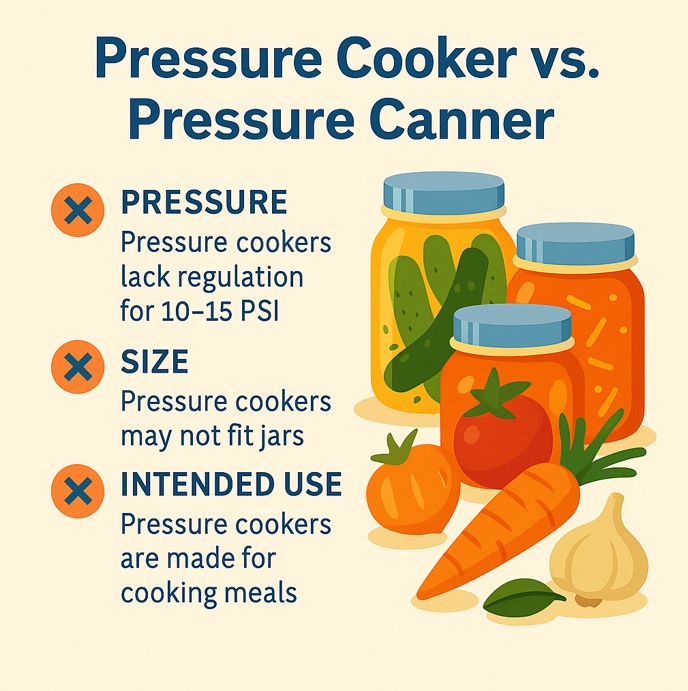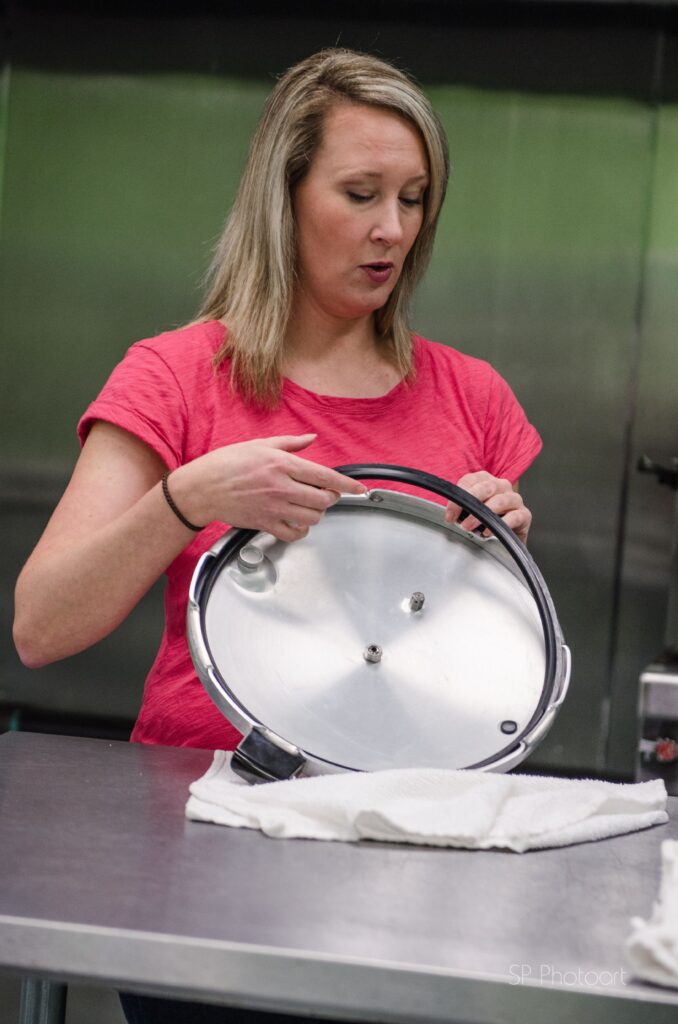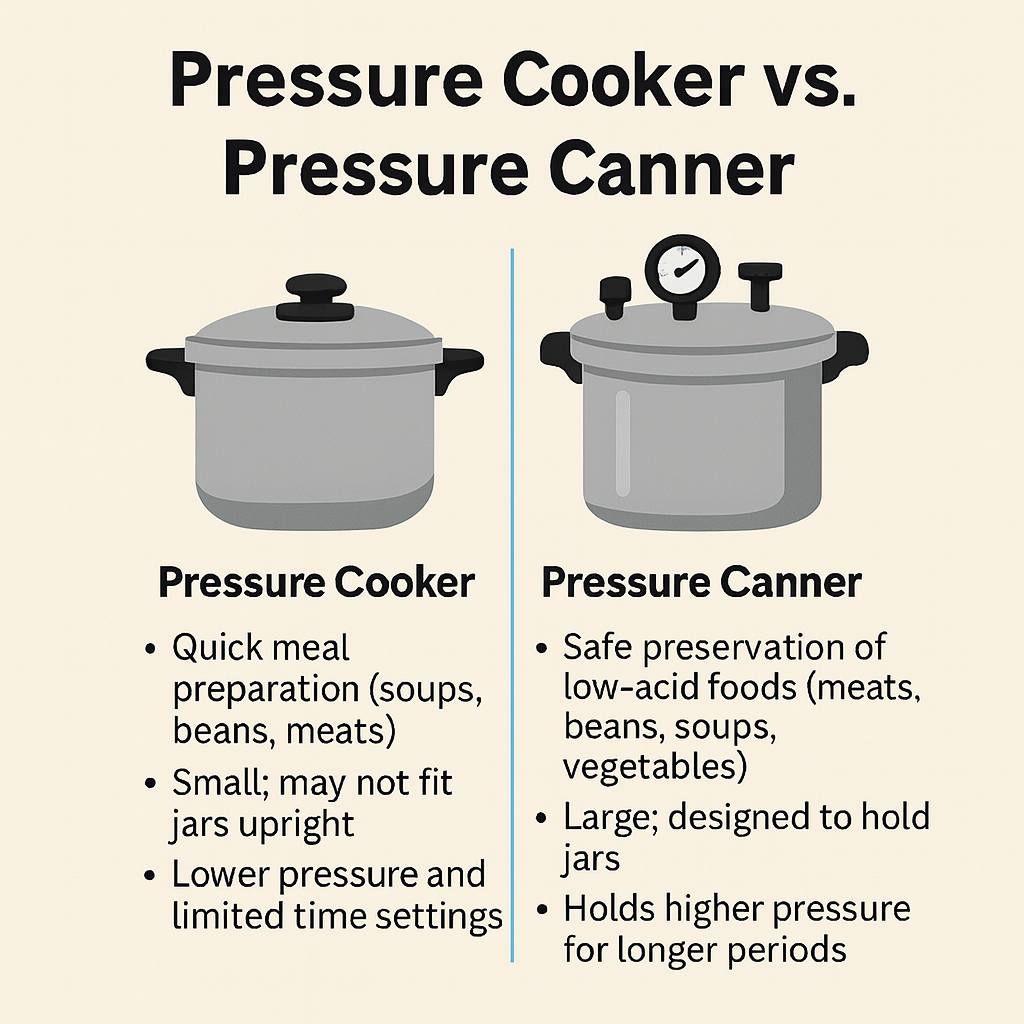Many people wonder if their pressure cooker can double as a pressure canner for preserving foods at home. While the terms “pressure cooker” and “pressure canner” are often used interchangeably, they are not the same tool. The difference lies in size, construction, and whether the appliance can reliably maintain the temperature required to destroy harmful bacteria and foodborne pathogens.
I sometimes use affiliate links in my content. This will not cost you anything but it helps me offset my costs to keep creating new canning recipes. Thank you for your support.
Last updated: August 28, 2025
Key Takeaways
- A pressure cooker is not the same as a pressure canner—the difference impacts our ability to preserve food for long-term storage and shelf stability.
- Pressure cookers are designed for quick cooking, while pressure canners are built to safely process jars of food for long-term storage, meaning shelf stability without the need for refrigeration.
- A suitable sized pressure canner must be large enough to hold four quart jars upright and have a reliable pressure regulating system.
- Digital canners and digital pressure cookers are not interchangeable.
- Using the wrong appliance can risk under-processing food, failing to destroy deadly bacteria and foodborne pathogens causing the food to rot during storage or cause illness when consumed.

Pressure Cooker vs. Pressure Canner: What’s the Difference?
At first glance, the terms sounds interchangeable. Both use steam pressure to cook food at higher temperatures greater than boiling water temperature, in excess of 212°F/100°C, something that cannot be achieved on the stovetop. However, the intended use and design of each kitchen appliance are very different:
- Pressure Cooker: A kitchen appliance designed to cook raw food quickly using high heat. They are smaller in size usually not exceeding 8 to 12 quarts in volume. More importantly, most consumer pressure cookers (including electric models like the original Instant Pot) are not designed to regulate pressure for extended periods of time nor do they offer the ability to sustain the higher temperatures required for food preservation.
- Pressure Canner: A specialized kitchen appliance designed and intended to process jars of food so they may be stored long-term without refrigeration. A true pressure canner must be large enough to fit at least four quart jars standing upright, with room inside the vessel for adequate steam circulation. It includes either a dial gauge or a weighted gauge that allows you to monitor and maintain pressure at the correct levels so you may achieve the required temperature for food preservation (240°F/116°C).
Why a Pressure Cooker Cannot Replace a Pressure Canner
1. Size Matters: Most pressure cookers are too small. Safe canning requires proper jar placement onto a flat rack resting on the bottom of the vessel, adequate steam circulation, and ample headspace inside the canner. If the vessel cannot hold four quart jars standing upright with their lid and ring adhered, it is not a certified canner.
2. Pressure Monitoring: Pressure cookers are designed for accelerated cooking using high pressure for short durations (from 5 to 60 minutes depending on the recipe.) They are not specifically engineered for precise temperature control nor have the ability to sustain a consistent temperature for a required length of time.
3. Temperature Consistency: Pressure cookers fluctuate too much in heat and pressure, creating unsafe conditions and causing too many vast temperature swings. Even if a pressure cooker could get to 10 PSI, it is not made to maintain said pressure consistently for 90 or more minutes.
4. Construction: Pressure canners aren’t just larger; they’re engineered with structural and safety features specifically for maintaining 10–15 PSI over extended processing times (60–100+ minutes).
5. Electric Models (Like Instant Pot): Most electric pressure cookers specifically state within their manuals that they are not approved for home canning. The heating element cycles, and the pressure cannot be verified or adjusted based on your altitude.

What About Digital Canners?
In recent years, digital canners have entered the market, adding even more confusion. These appliances look similar to digital pressure cookers, but their programming and intended use are very different:
- Digital Pressure Cookers: Only for cooking food. Not designed for water bath or pressure canning.
- Digital Water Bath Canners: Some digital models only allow you to safely water bath high-acid foods such as jams, jellies, and pickles. These are useful for small-batch canning but cannot safely process low-acid foods.
- Digital Pressure Canners: Certain models offer both water bath and pressure canning settings. These are designed with the size, pressure regulation, and processing controls necessary for safe food preservation. While others were only designed for water bath canning and not pressure canning. Reading the product manual and not the marketing materials is the best way to determine what type of canning is permitted in the specific canner model.
The key distinction is that digital canners are tested and programmed for home canning following the low-acid food processing guidelines, whereas digital pressure cookers are not programmed to do so. Before purchasing an unknown digital brand, always read the manufacturer’s specifications carefully to ensure the appliance is approved for canning, not just cooking.
Why Pressure Canners Are Built Differently
A pressure canner isn’t just a “bigger” version of a pressure cooker—it’s built with construction and safety features that make prolonged, high-pressure processing possible.
1. Pressure Capacity and Endurance
- Pressure canners are designed to hold 10–15 PSI steadily for 100+ minutes without strain on the vessel or the lid.
- Pressure cookers, especially smaller models, are designed for short bursts of cooking (20–30 minutes). Extending their use risks uneven heat, gasket failure, or dangerous pressure swings.

2. Lid Locking Systems
- Canners feature heavy-duty lid locks (twist-lock or screw-down systems with wing nuts) that secure the lid tightly during extended canning cycles.
- Cookers often use lighter, spring-loaded lid locks designed for quick-release convenience, not sustained processing.
3. Multiple Safety Valves
- Pressure canners include redundant safety features: a primary regulator (dial or weight), a vent pipe, and at least one backup safety release plug in case excess pressure builds.
- Cookers generally have only a single safety release, which may be sufficient for short cooking but not prolonged, precise canning cycles.
4. Gauges and Regulation
- Canners have either a calibrated dial gauge or a weighted gauge regulator, allowing the user to monitor and adjust PSI precisely for altitude and recipe requirements.
- Cookers lack these monitoring tools—users cannot verify or adjust pressure with the accuracy required for safe preservation.
5. Size and Stability
- Canners are built with thicker walls and bases, helping distribute and hold heat evenly throughout a long processing period.
- Cookers are lighter-weight, with thinner walls that can fluctuate more in temperature under long cycles.
At the end of the day, pressure cookers are great for meals, but they’re not engineered for safety, accuracy, or endurance when it comes to preserving food. A true pressure canner gives you not only the volume for jars but also the construction, monitoring, and safety features to protect both your food and your household.
What About Instant Pots For Home Canning?
I often get emails and messages about the Instant Pot, namely their Max and Pro Plus models. In the past, some Instant Pot models (like the Max and Pro Plus) were marketed with a “Canning” button. Early manuals even listed pressure ranges and times for both water bath and pressure canning, which included instructions for using 15 psi for low acid preservation. However, if you check the current manuals on the Instant Pot website, you’ll notice those references are now gone and they no longer offer a “canning” button on the units. Click here for the Max model manual and here for the Pro Plus model manual.
This means that Instant Brands have stopped promoting their appliances for home canning. However, the exact date as to when this stopped, I do not know. While the button may still exist on some older machines, consumers will no longer find instructions in the online manuals. In short, Instant Pots are not recognized or supported by their own manufacturer for pressure canning or water bathing.
Pressure Cooker vs. Pressure Canner at a Glance
| Feature | Pressure Cooker | Pressure Canner |
| Primary Purpose | Quick meal preparation (soups, beans, meats, rice) | Safe preservation of low-acid foods (meats, beans, soups, vegetables) |
| Size & Capacity | Small; often 4–8 quarts; may not fit jars upright | Large; 16–41 quarts; designed to hold multiple pint or quart jars upright |
| Pressure Range | Usually 5–12 PSI, designed for cooking cycles | Holds 10–15 PSI steadily for 60–110+ minutes |
| Monitoring Tools | Basic pressure valve, sometimes digital display | Calibrated dial gauge or weighted gauge for precise control |
| Safety Features | Simple locking lid; single safety release | Heavy-duty lid locks; multiple redundant safety valves and plugs |
| Approved Uses | Cooking meals only | Pressure canning low-acid foods; can also water bath high-acid foods |
| Examples | Instant Pot, stovetop pressure cookers | Presto, All American, Mirro, Carey digital pressure canner |
Choosing the Right Tool for Safe Home Canning
If you want to preserve low-acid foods, invest in a true pressure canner—whether stovetop or digital. Popular, trusted brands include All American, Presto, and Mirro for stovetop models, while select digital canners (like the Carey Nesco or the Presto Precise Digital Pressure Canner) are now available for those who prefer set-it-and-forget-it convenience.
People Often Ask
Q: Are digital pressure canners safe to use?
A: Yes, if the model is specifically designed for home canning. Be sure not to rely solely on product marketing and take the time to read the manufacturer’s manual online prior to making a purchase of an unfamiliar brand. Well established brands like Carey and Presto have won the hearts of thousands of home canners, some often purchasing two or three digital models to avoid using a stovetop model when canning large batches.
Q: Why are pressure canners so big?
A: The size allows quart jars to stand upright with enough clearance for steam circulation, ensuring even heat penetration. They are also designed to help canners maximize their yield so we may process many jars at a time. Some pressure canners are designed taller so you may purchase an additional flat rack to stack your jars. A 23-quart Presto pressure canner allows you to double stack pint jars, yielding upwards of 19 pints processed at a time. Other manufactures like the All American, have a model 941 that permits canners to double stack quart jars processing 20 quart jars at one time.
About the Author:
Diane Devereaux, The Canning Diva®, is a nationally recognized food preservation expert, author, and educator with over 30 years of home canning experience. She’s the author of multiple top-selling canning books and teaches workshops across the U.S. Learn more at TheCanningDiva.com.

